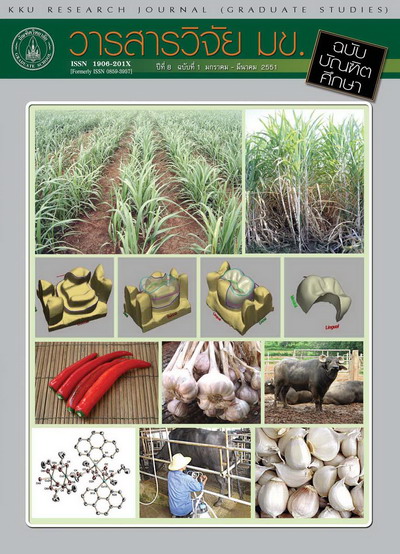Spectrophotometric Analysis of Optical Translucency, Opalescence, and Contrast of Leucite Ceramic for CAD-CAM Restoration as a Role of Ceramic Thickness
Keywords:
Translucency(ความโปร่งแสง), Opalescence(ความขุ่นใส ), Contrast(ความคมเข้ม), CAD-CAM(แคทแคม), Optical property(คุณสมบัติเชิงแสง)Abstract
The esthetic success of CAD-CAM ceramic restorations depends on good color determination of ceramic restoration that directly related to their optical properties. This study determines the effect of CAD-CAM ceramic thickness on their optical parameters (translucency, opalescence, and contrast). Ceramic discs (Ø 8 mm) at thickness of 0.7, 1.0, 1.3, 1.6, 1.8, and 2.0 mm were prepared from Empress CAD® ceramic blocks shade A1, A2, A3, and A3.5 (15 discs for each group) and polished with 1 μm diamond abrasive in Ecomet®3. The CIE L*, a*, b*, and ΔE parameters of discs were determined upon black and white backings using a spectrophotometer (ColorQuest®XE) with D65 illuminant and 10 degree observer. The translucency parameter (TP), opalescence index (OI), and contrast ratio(C) were calculated and analyzed using ANOVA and regression analysis. The results revealed that changing in ceramic thickness affected to the optical parameter of ceramic tested in each shade (P < 0.05). As the ceramic thickness increased, a significant reduction in TP, OI and C values (P < 0.05) with extremely high correlation coefficients with TP as well as high correlation coefficient with OI and C.
ความสำเร็จของการบูรณะฟันด้วยวัสดุเซรามิกส์ชนิดแคทแคมขึ้นอยู่กับการเลือกสีของวัสดุเซรามิกส์เป็นสำคัญ อันมีความสัมพันธ์โดยตรงกับคุณสมบัติของวัสดุที่เกี่ยวข้องกับแสง การศึกษานี้เพื่อประเมินปัจจัยขอความหนาของเซรามิกส์ที่ใช้ในการบูรณะต่อความโปร่งแสง ความขุ่นใส และความคมเข้ม โดยทำการเตรียมชิ้นเซรามิกส์ยี่ห้อเอมเพรสแคดสี A1, A2, A3 และ A3.5 ให้มีเส้นผ่าศูนย์กลาง 8 ม.ม. และมีความหนา 0.7, 1.0, 1.3, 1.6, 1.8 และ 2.0 ม.ม. แล้วทำการขัดด้วยผงขัดความละเอียด 1 ไมครอนด้วยเครื่อง Ecomet 3 แล้วทำการวัดค่าของสีได้แก่ CIE L*, a*, b* และ ΔE ด้วยฉากหลังสีขาวและสีดำ โดยใช้เครื่องสเปคโตรโฟโตมิเตอร์ ที่กำหนดค่าความสว่างที่ D65 และมุมของการสังเกตที่ 10 องศา แล้วทำการคำนวณค่า ความโปร่งแสง ความขุ่นใส และความคมเข้ม รวมทั้งทำการวิเคราะห์ความแปรปรวนและการวิเคราะห์ความถดถอย ผลการศึกษาพบว่าการเปลี่ยนแปลงความหนาของเซรามิกส์ส่งผลต่อคุณสมบัติเชิงแสงของเซรามิกอย่างมีนัยสำคัญ (P < 0.05) โดยความหนาของเซรามิกส์ที่เพิ่มขึ้นจะสัมพันธ์กันอย่างยิ่งกับค่าความโปร่งแสง และในทำนองเดียวกันจะสัมพันธ์กับความขุ่นใสและความคมเข้มของเรามิกที่ลดลง



